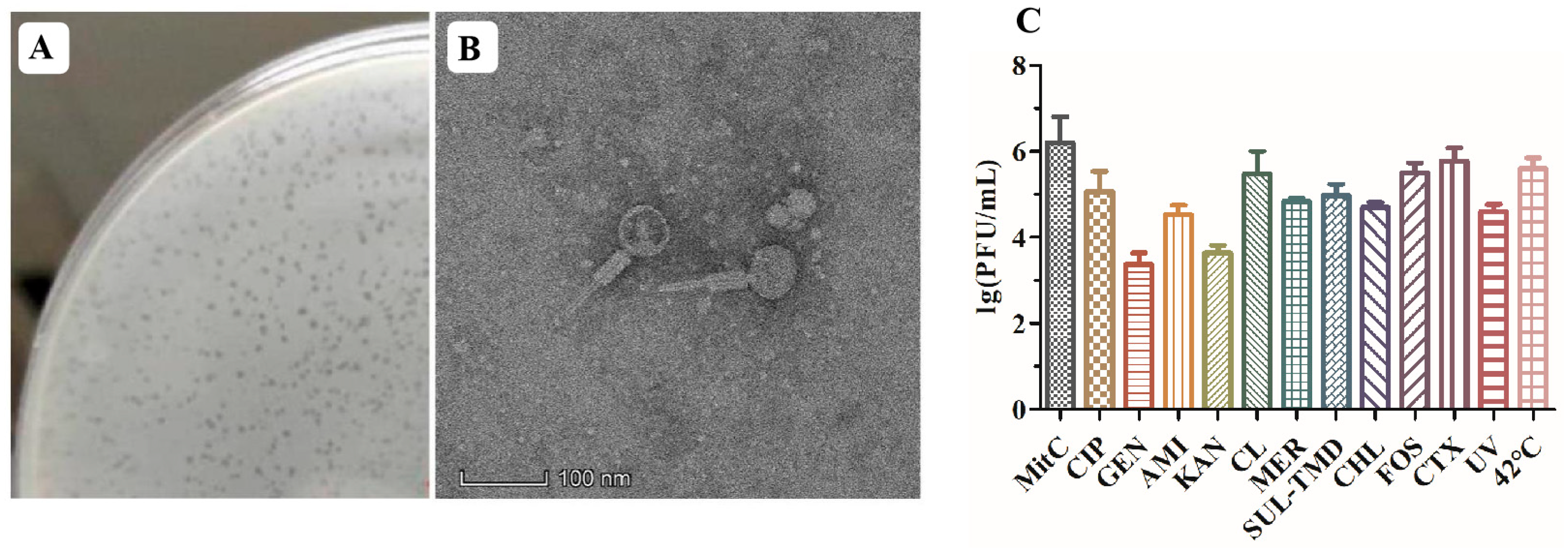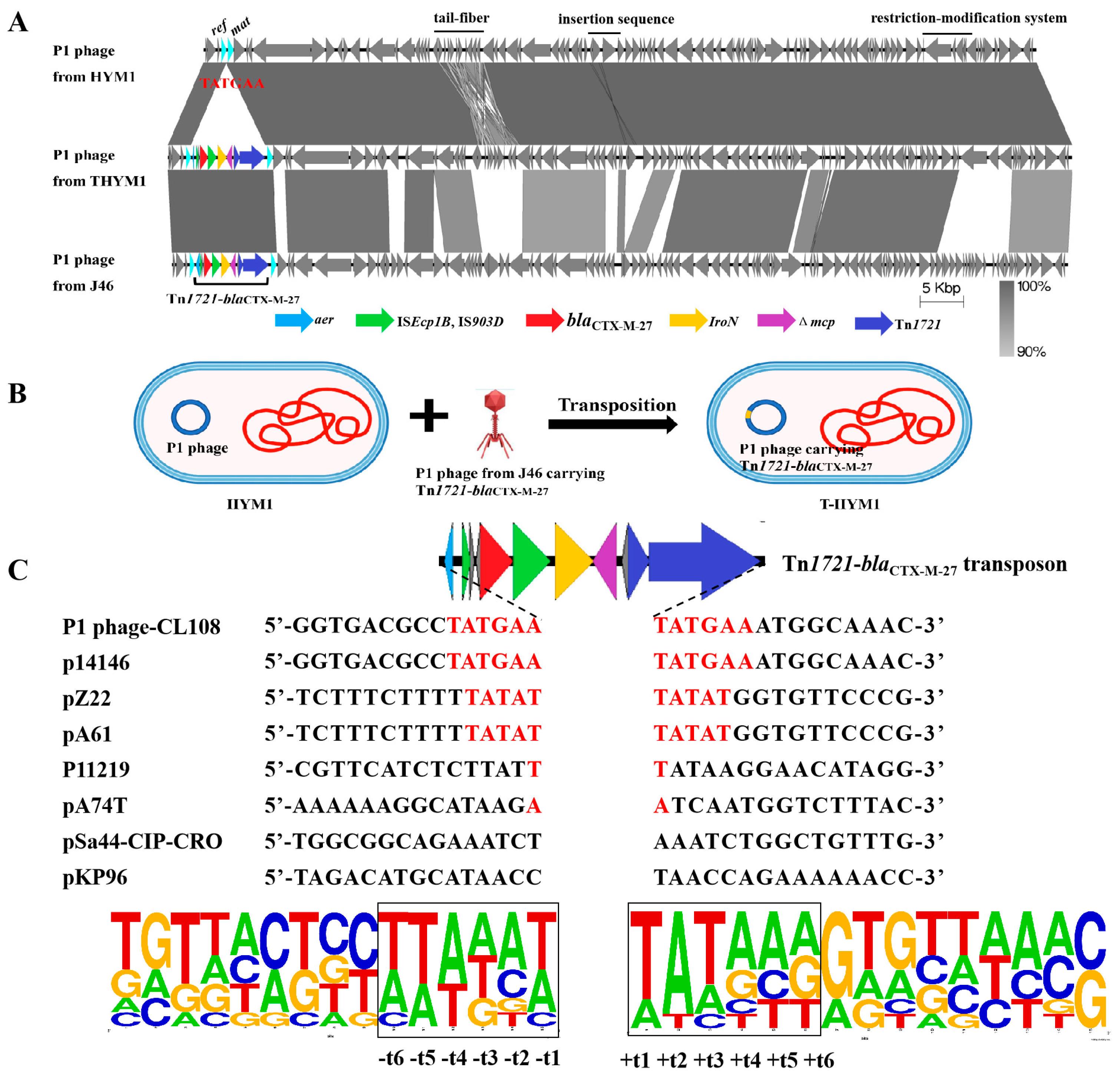Characterization of Salmonella Phage P1-CTX and the Potential Mechanism Underlying the Acquisition of the blaCTX-M-27 Gene
Abstract
1. Introduction
2. Results and Discussion
2.1. Plaque and Morphology of the P1-CTX Phage
2.2. Induction Conditions for the P1-CTX Phage
2.3. Transduction of the P1-CTX Phage
2.4. Movement Mechanism of Tn Acquisition by P1 Phage
3. Materials and Methods
3.1. Plaque Assays and TEM Assays
3.2. Induction Conditions
3.3. Transduction and Host
3.4. Whole-Genome Sequencing
3.5. ARGs in P1 phage
4. Conclusions
Supplementary Materials
Author Contributions
Funding
Institutional Review Board Statement
Informed Consent Statement
Data Availability Statement
Acknowledgments
Conflicts of Interest
References
- Pulingam, T.; Parumasivam, T.; Gazzali, A.M.; Sulaiman, A.M.; Chee, J.Y.; Lakshmanan, M.; Chin, C.F.; Sudesh, K. Antimicrobial resistance: Prevalence, Economic Burden, Mechanisms of Resistance and Strategies to Overcome. Eur. J. Pharm. Sci. 2022, 170, 106103. [Google Scholar] [CrossRef] [PubMed]
- Birgy, A.; Levy, C.; Nicolas-Chanoine, M.H.; Cointe, A.; Hobson, C.A.; Magnan, M.; Bechet, S.; Bidet, P.; Cohen, R.; Bonacorsi, S. Independent Host Factors and Bacterial Genetic Determinants of the Emergence and Dominance of Escherichia coli Sequence Type 131 CTX-M-27 in a Community Pediatric Cohort Study. Antimicrob. Agents Chemother. 2019, 63, e00382-19. [Google Scholar] [CrossRef] [PubMed]
- Ghosh, H.; Doijad, S.; Falgenhauer, L.; Fritzenwanker, M.; Imirzalioglu, C.; Chakraborty, T. bla(CTX-M-27)-Encoding Escherichia coli Sequence Type 131 Lineage C1-M27 Clone in Clinical Isolates, Germany. Emerg. Infect. Dis 2017, 23, 1754–1756. [Google Scholar] [CrossRef] [PubMed]
- Kim, S.Y.; Ko, K.S. Diverse Plasmids Harboring bla(CTX-M-15) in Klebsiella pneumoniae ST11 Isolates from Several Asian Countries. Microb. Drug Resist. 2019, 25, 227–232. [Google Scholar] [CrossRef] [PubMed]
- Matsumura, Y.; Pitout, J.D.; Gomi, R.; Matsuda, T.; Noguchi, T.; Yamamoto, M.; Peirano, G.; Devinney, R.; Bradford, P.A.; Motyl, M.R.; et al. Global Escherichia coli Sequence Type 131 Clade with bla(CTX-M-27) Gene. Emerg. Infect. Dis 2016, 22, 1900–1907. [Google Scholar] [CrossRef] [PubMed]
- Merino, I.; Hernandez-Garcia, M.; Turrientes, M.C.; Perez-Viso, B.; Lopez-Fresnena, N.; Diaz-Agero, C.; Maechler, F.; Fankhauser-Rodriguez, C.; Kola, A.; Schrenzel, J.; et al. Emergence of ESBL-producing Escherichia coli ST131-C1-M27 clade colonizing patients in Europe. J. Antimicrob. Chemother. 2018, 73, 2973–2980. [Google Scholar] [CrossRef] [PubMed]
- Becerra-Aparicio, F.; Gomez-Zorrilla, S.; Hernandez-Garcia, M.; Gijon, D.; Siverio, A.; Berbel, D.; Sanchez-Carrillo, C.; Cercenado, E.; Rivera, A.; de Malet, A.; et al. Significant Increase of CTX-M-15-ST131 and Emergence of CTX-M-27-ST131 Escherichia coli High-risk Clones Causing Healthcare-associated Bacteraemia of Urinary Origin in Spain (ITUBRAS-2 project). J. Antimicrob. Chemother. 2023, 78, 2291–2296. [Google Scholar] [CrossRef] [PubMed]
- Liu, G.; Qian, H.; Tang, B.; Chen, Y.; Kang, H.; Jiang, F.; Ma, P.; Gu, B.; Huo, X. Prevalence and Characterisation of Third-generation Cephalosporin-resistant Shigella flexneri Isolates from Jiangsu Province, China, 2013–2015. J. Glob. Antimicrob. Resist. 2018, 15, 283–287. [Google Scholar] [CrossRef] [PubMed]
- Bai, L.; Zhao, J.; Gan, X.; Wang, J.; Zhang, X.; Cui, S.; Xia, S.; Hu, Y.; Yan, S.; Wang, J.; et al. Emergence and Diversity of Salmonella enterica Serovar Indiana Isolates with Concurrent Resistance to Ciprofloxacin and Cefotaxime from Patients and Food-Producing Animals in China. Antimicrob. Agents Chemother. 2016, 60, 3365–3371. [Google Scholar] [CrossRef] [PubMed]
- Weisberg, A.J.; Chang, J.H. Mobile Genetic Element Flexibility as an Underlying Principle to Bacterial Evolution. Annu. Rev. Microbiol. 2023, 77, 603–624. [Google Scholar] [CrossRef]
- Humphrey, S.; Fillol-Salom, A.; Quiles-Puchalt, N.; Ibarra-Chavez, R.; Haag, A.F.; Chen, J.; Penades, J.R. Bacterial Chromosomal Mobility via Lateral Transduction Exceeds That of Classical Mobile Genetic Elements. Nat. Commun. 2021, 12, 6509. [Google Scholar] [CrossRef] [PubMed]
- Chen, J.; Quiles-Puchalt, N.; Chiang, Y.N.; Bacigalupe, R.; Fillol-Salom, A.; Chee, M.; Fitzgerald, J.R.; Penades, J.R. Genome Hypermobility by Lateral Transduction. Science 2018, 362, 207–212. [Google Scholar] [CrossRef] [PubMed]
- Wang, M.; Jiang, L.; Wei, J.; Zhu, H.; Zhang, J.; Liu, Z.; Zhang, W.; He, X.; Liu, Y.; Li, R.; et al. Similarities of P1-Like Phage Plasmids and Their Role in the Dissemination of bla(CTX-M-55). Microbiol. Spectr. 2022, 10, e141022. [Google Scholar] [CrossRef] [PubMed]
- Venturini, C.; Zingali, T.; Wyrsch, E.R.; Bowring, B.; Iredell, J.; Partridge, S.R.; Djordjevic, S.P. Diversity of P1 Phage-like Elements in Multidrug Resistant Escherichia coli. Sci. Rep. 2019, 9, 18861. [Google Scholar] [CrossRef] [PubMed]
- Bai, L.; Wang, J.; Hurley, D.; Yu, Z.; Wang, L.; Chen, Q.; Li, J.; Li, F.; Fanning, S. A Novel Disrupted mcr-1 Gene and a Lysogenized Phage P1-like Sequence Detected from a Large Conjugative Plasmid, Cultured from a Human Atypical Enteropathogenic Escherichia coli (aEPEC) Recovered in China. J. Antimicrob. Chemother. 2017, 72, 1531–1533. [Google Scholar] [CrossRef] [PubMed][Green Version]
- Yang, L.; Li, W.; Jiang, G.Z.; Zhang, W.H.; Ding, H.Z.; Liu, Y.H.; Zeng, Z.L.; Jiang, H.X. Characterization of a P1-like Bacteriophage Carrying CTX-M-27 in Salmonella spp. Resistant to Third Generation Cephalosporins Isolated from Pork in China. Sci. Rep. 2017, 7, 40710. [Google Scholar] [CrossRef] [PubMed]
- Zhao, Q.Y.; Li, W.; Cai, R.M.; Lu, Y.W.; Zhang, Y.; Cai, P.; Webber, M.A.; Jiang, H.X. Mobilization of Tn1721-like Structure Harboring blaCTX-M-27 between P1-like Bacteriophage in Salmonella and Plasmids in Escherichia coli in China. Vet. Microbiol. 2021, 253, 108944. [Google Scholar] [CrossRef]
- Łobocka, M.B.; Rose, D.J.; Plunkett, G., 3rd; Rusin, M.; Samojedny, A.; Lehnherr, H.; Yarmolinsky, M.B.; Blattner, F.R. Genome of bacteriophage P1. J. Bacteriol. 2004, 186, 7032–7068. [Google Scholar] [CrossRef] [PubMed]
- Stanczak-Mrozek, K.I.; Laing, K.G.; Lindsay, J.A. Resistance Gene Transfer: Induction of Transducing Phage by Sub-inhibitory Concentrations of Antimicrobials is Not Correlated to Induction of Lytic Phage. J. Antimicrob. Chemother. 2017, 72, 1624–1631. [Google Scholar] [CrossRef] [PubMed]
- Goerke, C.; Koller, J.; Wolz, C. Ciprofloxacin and Trimethoprim Cause Phage Induction and Virulence Modulation in Staphylococcus aureus. Antimicrob. Agents Chemother. 2006, 50, 171–177. [Google Scholar] [CrossRef] [PubMed]
- Billard-Pomares, T.; Fouteau, S.; Jacquet, M.E.; Roche, D.; Barbe, V.; Castellanos, M.; Bouet, J.Y.; Cruveiller, S.; Medigue, C.; Blanco, J.; et al. Characterization of a P1-like Bacteriophage Carrying an SHV-2 Extended-spectrum Beta-lactamase from an Escherichia coli Strain. Antimicrob. Agents Chemother. 2014, 58, 6550–6557. [Google Scholar] [CrossRef] [PubMed]
- Greig, D.R.; Bird, M.T.; Chattaway, M.A.; Langridge, G.C.; Waters, E.V.; Ribeca, P.; Jenkins, C.; Nair, S. Characterization of a P1-bacteriophage-like Plasmid (Phage-plasmid) Harbouring bla(CTX-M-15) in Salmonella enterica Serovar Typhi. Microb. Genomics 2022, 8, mgen000913. [Google Scholar] [CrossRef] [PubMed]
- Galetti, R.; Andrade, L.N.; Varani, A.M.; Darini, A. A Phage-Like Plasmid Carrying blaKPC-2 Gene in Carbapenem-Resistant Pseudomonas aeruginosa. Front. Microbiol. 2019, 10, 572. [Google Scholar] [CrossRef] [PubMed]
- Jiang, L.; Zhu, H.; Wei, J.; Jiang, L.; Li, Y.; Li, R.; Wang, Z.; Wang, M. Enterobacteriaceae Genome-wide Analysis Reveals Roles for P1-like Phage-plasmids in Transmission of mcr-1, tetX4 and Other Antibiotic resistance Genes. Genomics 2023, 115, 110572. [Google Scholar] [CrossRef] [PubMed]
- Leon, M.; Santander, J.; Curtiss, R.R.; Robeson, J. Natural Lysogenization and Transduction in Salmonella enterica serovar Choleraesuis by Bacteriophage P1. Res. Microbiol. 2013, 164, 1–5. [Google Scholar] [CrossRef] [PubMed]
- Zhang, Z.; Chang, J.; Xu, X.; Hu, M.; He, S.; Qin, X.; Zhou, M.; Shi, C.; Shi, X. Phylogenomic Analysis of Salmonella enterica Serovar Indiana ST17, an Emerging Multidrug-Resistant Clone in China. Microbiol. Spectr. 2022, 10, e0011522. [Google Scholar] [CrossRef] [PubMed]
- Fang, L.X.; Li, X.P.; Deng, G.H.; Li, S.M.; Yang, R.S.; Wu, Z.W.; Liao, X.P.; Sun, J.; Liu, Y.H. High Genetic Plasticity in Multidrug-Resistant Sequence Type 3-IncHI2 Plasmids Revealed by Sequence Comparison and Phylogenetic Analysis. Antimicrob. Agents Chemother. 2018, 62, e02068-17. [Google Scholar] [CrossRef] [PubMed]
- Tang, Y.; Li, G.; Liang, W.; Shen, P.; Zhang, Y.; Jiang, X. Translocation of Carbapenemase Gene blaKPC-2 both Internal and External to Transposons Occurs via Novel Structures of Tn1721 and Exhibits Distinct Movement Patterns. Antimicrob. Agents Chemother. 2017, 61, e01151-17. [Google Scholar] [CrossRef] [PubMed]
- He, Y.Z.; Long, T.F.; He, B.; Li, X.P.; Li, G.; Chen, L.; Liao, X.P.; Liu, Y.H.; Sun, J. ISEc69-Mediated Mobilization of the Colistin Resistance Gene mcr-2 in Escherichia coli. Front. Microbiol. 2020, 11, 564973. [Google Scholar] [CrossRef] [PubMed]
- Pribil, P.A.; Haniford, D.B. Target DNA Bending is an Important Specificity Determinant in Target Site Selection in Tn10 Transposition. J. Mol. Biol. 2003, 330, 247–259. [Google Scholar] [CrossRef] [PubMed]
- Chiang, Y.N.; Penades, J.R.; Chen, J. Genetic Transduction by Phages and Chromosomal Islands: The New and Noncanonical. PLoS Pathog. 2019, 15, e1007878. [Google Scholar] [CrossRef] [PubMed]
- Li, J.; Li, Y.; Ding, Y.; Huang, C.; Zhang, Y.; Wang, J.; Wang, X. Characterization of a Novel Siphoviridae Salmonella Bacteriophage T156 and its Microencapsulation Application in Food Matrix. Food Res. Int. 2021, 140, 110004. [Google Scholar] [CrossRef]
- Wick, R.R.; Judd, L.M.; Gorrie, C.L.; Holt, K.E. Unicycler: Resolving Bacterial Genome Assemblies from Short and Long Sequencing Reads. PLoS Comput. Biol. 2017, 13, e1005595. [Google Scholar] [CrossRef] [PubMed]
- Li, R.; Xie, M.; Dong, N.; Lin, D.; Yang, X.; Wong, M.; Chan, E.W.; Chen, S. Efficient Generation of Complete Sequences of MDR-encoding Plasmids by Rapid Assembly of MinION Barcoding Sequencing Data. GigaScience 2018, 7, gix132. [Google Scholar] [CrossRef] [PubMed]
- Okonechnikov, K.; Conesa, A.; Garcia-Alcalde, F. Qualimap 2: Advanced Multi-sample Quality Control for High-throughput Sequencing Data. Bioinformatics 2016, 32, 292–294. [Google Scholar] [CrossRef]
- Aziz, R.K.; Bartels, D.; Best, A.A.; Dejongh, M.; Disz, T.; Edwards, R.A.; Formsma, K.; Gerdes, S.; Glass, E.M.; Kubal, M.; et al. The RAST Server: Rapid Annotations Using Subsystems Technology. BMC Genom. 2008, 9, 75. [Google Scholar] [CrossRef] [PubMed]
- Bortolaia, V.; Kaas, R.S.; Ruppe, E.; Roberts, M.C.; Schwarz, S.; Cattoir, V.; Philippon, A.; Allesoe, R.L.; Rebelo, A.R.; Florensa, A.F.; et al. ResFinder 4.0 for Predictions of Phenotypes from Genotypes. J. Antimicrob. Chemother. 2020, 75, 3491–3500. [Google Scholar] [CrossRef]
- Siguier, P.; Perochon, J.; Lestrade, L.; Mahillon, J.; Chandler, M. ISfinder: The Reference Centre for Bacterial Insertion Sequences. Nucleic Acids Res. 2006, 34, D32–D36. [Google Scholar] [CrossRef] [PubMed]
- Crooks, G.E.; Hon, G.; Chandonia, J.M.; Brenner, S.E. WebLogo: A Sequence Logo Generator. Genome Res. 2004, 14, 1188–1190. [Google Scholar] [CrossRef] [PubMed]


| Strain | Species | Serotype | Source | Isolate Date |
|---|---|---|---|---|
| G67, H13, H35, H45, H75 | Salmonella | Derby | Pork | 2021 |
| R17 A85 B9 A92, B25 | Rissen | Pork | 2015 2014 2013 2016 | |
| BYC5, BYC8 YM7, YM11, JZ102 | Kentucky | Chicken meat Pork | 2016 | |
| G5, H5, H9, H43 | Typhimurium | Pork | 2021 | |
| BYC4 YXC6 H49 | Cerro | Chicken meat Chicken meat Pork | 2016 2016 2021 | |
| LJ23 | Senfutenber | Duck | 2009 | |
| HYM2 | Menster | Duck | 2018 | |
| RC15, HJM51 H145 | Escherichia coli | ND | Chicken Pork | 2018 2021 |
Disclaimer/Publisher’s Note: The statements, opinions and data contained in all publications are solely those of the individual author(s) and contributor(s) and not of MDPI and/or the editor(s). MDPI and/or the editor(s) disclaim responsibility for any injury to people or property resulting from any ideas, methods, instructions or products referred to in the content. |
© 2024 by the authors. Licensee MDPI, Basel, Switzerland. This article is an open access article distributed under the terms and conditions of the Creative Commons Attribution (CC BY) license (https://creativecommons.org/licenses/by/4.0/).
Share and Cite
Zhao, Q.-Y.; Cai, R.-M.; Cai, P.; Zhang, L.; Jiang, H.-X.; Zeng, Z.-L. Characterization of Salmonella Phage P1-CTX and the Potential Mechanism Underlying the Acquisition of the blaCTX-M-27 Gene. Antibiotics 2024, 13, 446. https://doi.org/10.3390/antibiotics13050446
Zhao Q-Y, Cai R-M, Cai P, Zhang L, Jiang H-X, Zeng Z-L. Characterization of Salmonella Phage P1-CTX and the Potential Mechanism Underlying the Acquisition of the blaCTX-M-27 Gene. Antibiotics. 2024; 13(5):446. https://doi.org/10.3390/antibiotics13050446
Chicago/Turabian StyleZhao, Qiu-Yun, Run-Mao Cai, Ping Cai, Lin Zhang, Hong-Xia Jiang, and Zhen-Ling Zeng. 2024. "Characterization of Salmonella Phage P1-CTX and the Potential Mechanism Underlying the Acquisition of the blaCTX-M-27 Gene" Antibiotics 13, no. 5: 446. https://doi.org/10.3390/antibiotics13050446
APA StyleZhao, Q.-Y., Cai, R.-M., Cai, P., Zhang, L., Jiang, H.-X., & Zeng, Z.-L. (2024). Characterization of Salmonella Phage P1-CTX and the Potential Mechanism Underlying the Acquisition of the blaCTX-M-27 Gene. Antibiotics, 13(5), 446. https://doi.org/10.3390/antibiotics13050446






